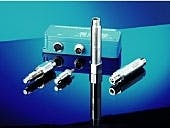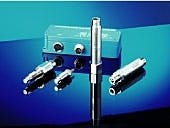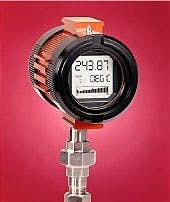Oil habitat of Yenisey-Khatanga basin, northern Siberia
This report offers information on the geology of this large area of northern Siberia immediately north of the East Siberian oil-gas province. Not only is the potential great for new petroleum discovery there, but also acquaintance with this oil-gas province provides the geologist with a broader understanding of the principles of petroleum geology, the author says. This basin is part of the West Siberian oil-gas province.
Chapter headings are Position of Basin in Regional Structure; Exploration History; Stages in Development of the Basin; Internal Structure of the Basin; Source Beds and Catagenesis; Reservoirs, Seals, and Zones of Oil-Gas Accumulation; Gas and Gas-Condensate Fields; and History of Pool Formation and Prospects for New Discoveries.
Source: Dr. James Clarke, 914 Leigh Mill Rd., Great Falls, VA 22066.
Pressure sensor handles 300 degrees C. heat
Sensors of the RH-high-pressure, hightemperature series can be used in exploration operations for direct measurement of hot media up to 300 degrees C. Because of their compact construction and silicon measuring cell, no toxic filling liquid is required. The sensor diaphragm enables units to be used at pressures of 100-5,000 bar absolute even under harsh conditions.
RH-transmitters are also certified as intrinsically safe for use in hazardous areas (EEx ia IIC T6...T1).
Additional features include a high level of stability and accuracy together with a high natural frequency, allowing them to record not only static pressures but also dynamic changes in pressure.
Source: Kristal Instrumente AG, Eulachstrasse 22, CH-8408 Winterthur, Switzerland.
Enhanced oil recovery video
BP has added another videotape on enhanced oil recovery to the list of videos that it can supply the industry free on request.
The latest video, "WAG: A Journey Through Pore Space," covers a joint industry project on water-alternating-gas (WAG) injection being done at Heriot-Watt University. The project aims at a better understanding of fluid movement in the reservoirs under different WAG schemes.
The video shows how physical micromodels are used to observe the behavior of fluids in pore space. Then data from these observations are entered into mathematical network models that mimic the structures of pores and the connections between them.
The video gives reservoir engineers an opportunity to observe the dynamics of WAG displacement in the water-wet pore space of a micromodel.
Other free for the asking videos include:
- Miscible Gas Injection From Theory to Practice, 43 min, 2000, PAL and NTSC formats.
- Gas Injection: Many Ways to Recover More Oil, 27 min, November 1999, PAL and NTSC formats.
- BP Miscible Gas Projects Around the World, 27 and 40 min versions, 1998, PAL, NTSC, and SECAM formats.
- Prudhoe Bay Miscible Gas Project, 20 and 35 min versions, 1993, PAL, NTSC, and SECAM formats. The 35 min version of the Prudhoe Bay video in addition to English is available in French, Chinese, and Russian. All other videos are in English only.
Source: BP, Chertsey Rd., Sunbury-on-Thames, Middlesex, TW16 7LN, UK.
Transmitter features dual-compartment enclosure
The new THZ Smart HART temperature transmitter features a dual-compartment enclosure with an isolation seal that protects the transmitter's electronics from moisture and corrosives brought in through conduit entries. A glass window is built into the front cap for easy viewing of process status in the field. Removable front and rear caps help enable quick access to the terminal block and simplify transmitter removal or replacement without disturbing the enclosure or sensor assembly. The flexible spring sensor allows the RTD or thermocouple sensor to slide out of the thermowell without removal of the transmitter or enclosure.
The large five-digit display delivers process status, output in percent of span, and diagnostic information to the field. With Smart HART technology, this transmitter is accurate up to plus or minus 0.025 degrees F. (plus or minus 0.0140 degrees C.). The THZ also features stability-allowing up to 5 years between calibrations. Using a standard HART hand-held communicator or intelligent configuration software with an on-line HelpMap system, the unit sets up in a minute or less to handle nearly all available RTD and thermocouple sensors with isolated 4-20 ma or digital HART output.
Sensor-to-transmitter matching together with NIST traceable test data are available from an on-site calibration lab. Ready-to-install assemblies complete with THZ, sensor, thermowell, process fittings, and housing combinations for mounting in general purpose or explosionproof applications can be ordered using a single part number.
Source: Moore lndustries-lnternational Inc., 16650 Schoenborn St., Sepulveda, CA 91343.




